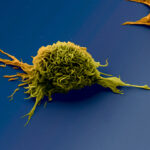Link to Pubmed [PMID] – 19286519
Link to DOI – 10.1126/science.1170540
Science 2009 Apr; 324(5925): 392-7
Dendritic cells (DCs) in lymphoid tissue arise from precursors that also produce monocytes and plasmacytoid DCs (pDCs). Where DC and monocyte lineage commitment occurs and the nature of the DC precursor that migrates from the bone marrow to peripheral lymphoid organs are unknown. We show that DC development progresses from the macrophage and DC precursor to common DC precursors that give rise to pDCs and classical spleen DCs (cDCs), but not monocytes, and finally to committed precursors of cDCs (pre-cDCs). Pre-cDCs enter lymph nodes through and migrate along high endothelial venules and later disperse and integrate into the DC network. Further cDC development involves cell division, which is controlled in part by regulatory T cells and fms-like tyrosine kinase receptor-3.

